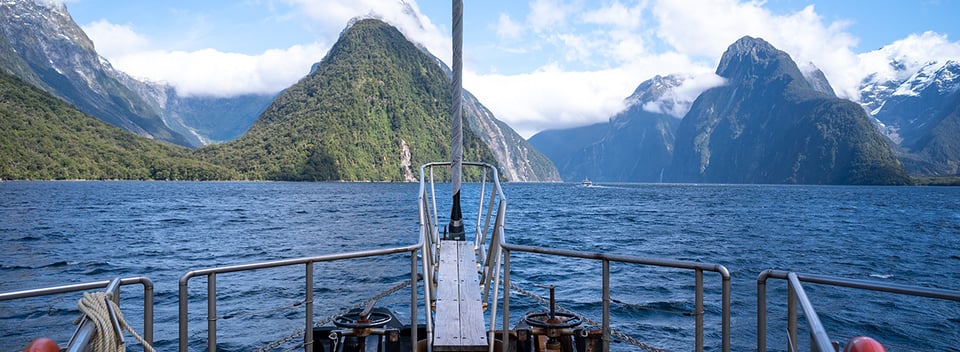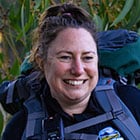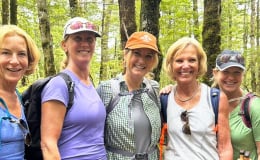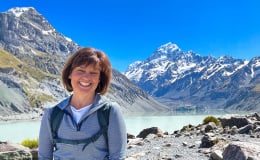
5 Reasons Milford Sound is Best in the Rain

With an average of 182 days of rain a year, there’s a good chance that a visit to New Zealand’s iconic Milford Sound will involve at least a short shower. But don’t let that put you off – it’s all just part of the Milford Sound experience.
Imagine sheer granite cliffs with waterfalls like lightning strikes tumbling down their faces; dark and moody clouds clinging to the mountaintops, belying their true dimensions; mist drifting off waterfalls that tumble ferociously from hidden lakes and rainbows that come and go like magic. There’s a lot to be said for visiting Milford Sound in the rain, and in our slightly biased opinion, that's the best time to go.
1. The magic of Milford Sound
Travellers visiting New Zealand are often enamoured by the country's unrivalled natural beauty, and Milford Sound is one of the most photographed and well known of all the scenic locations in Aotearoa (New Zealand), drawing in nearly a million visitors each year.
With mountains that seem to rise straight up out of the ocean, trees that inexplicably cling onto cliff faces and rainforest all around, it‘s easy to fall in love with this natural wonder. The drama that comes with visiting Milford Sound is what draws people in year after year, and when it rains here that drama is amplified.
Milford Sound is actually a fiord (not a sound)! It's also the only fiord in New Zealand accessible by road.
2. A waterfall chaser's paradise
Milford Sound rain increases the already mighty permanent waterfalls and creates hundreds of temporary ones cascading down cliff faces in a fury of power and beauty.
The highest, most well-known and liberally photographed Milford Sound waterfall is the Lady Bowen Falls, standing at an impressive 162m (531ft). Not only breathtakingly beautiful, without it Milford Sound couldn’t operate as the falls are the sole source of power and water for the tiny village. The Lady Bowen Falls quadruples in volume during Milford’s epic storms – one of the best ways to truly enjoy the falls is to stand on the foreshore and feel the spray.
In Maori, the falls are known as Hine Te Awa meaning ‘girl on the river’, after the lower third of the falls that resemble the plumage of the Kereru (NZ Wood Pigeon).
The silver medal for size goes to Stirling Falls, a staggering 151m (494ft) in height – three times the height of Niagara Falls- but the 1,300m (4,265ft) mountain behind makes the falls look deceptively small. Made famous by Hugh Jackman’s epic jump in the movie Wolverine, the sheer drop of Stirling Falls allows boats and intrepid kayakers to get right underneath – just remember to take your rain gear and a waterproof camera to capture the moment. The falls were named by Captain Stirling, who deemed his own name appropriate for the magnificent sight.
In Māori, the falls are known as Wai Manu meaning ‘cloud on the water’.

Stirling Falls, the second-highest of the Milford Sound waterfalls.
The Giant Gate Falls is a 30m (98ft) waterfall that seems to appear from nowhere, but does require a little work to reach it. Just an hour’s hike along the renowned Milford Track, hikers are rewarded by the falls and their drop into a stunning pool; brave visitors have been known to dive in for a swim on a warm day. The perfect spot to stop and have a hot cuppa and a bite to eat, just watch your food as there is a healthy population of Weka birds here, and at certain times of the year their chicks will try and share your snacks.
Now you see them, now you don’t - the Four Sisters are seemingly magical waterfalls that only appear during the Milford Sound rain. Identically sized, the four waterfalls line up along a mountainside. Often, the soft mist rising up from the falls make rainbows appear, skirting the waterfalls.
If the day allows, your boat cruise may even be guided right underneath these falls to fill an empty glass with this purest of water, inviting visitors to raise a toast to a very special location. Legend tells us that water from the Four Sisters will make you look 10 years younger (yes please, we'll take a glass of that!).
3. A rainforest isn’t a rainforest without the rain
There’s nothing better than the smell of the forest after heavy rainfall. Milford Sound boasts a lush temperate rainforest, and a rainforest cannot be without the rain.
Milford Sound is one of the wettest places on our planet – especially the Cleddau Valley that boasts a whopping average annual rainfall of 13m (43ft)! With no buffer to the wild winds on the west coast of New Zealand's South Island, the water-laden winds hit the steep mountainsides, rise quickly and drop their payload before heading over the Southern Alps – and this is why we have such incredible rainforests on the West Coast.

Milford Sound weather means the area is covered in rainforest.
This combination of rainforest, high rainfall and steep mountains come together to create an extraordinary aquatic environment. Milford Sound is a haven for divers who wish to explore marine life that can typically only be found in much deeper waters. One of the strangest facts about the sound is that the top 10m (33ft) or so of water is freshwater, not saltwater as you’d expect. The remaining approximately 265m (869ft) of the sound is sea-water, so this top layer is an anomaly, caused by the destination’s extreme rainfall and subsequent waterfalls. The freshwater has a slight tea colour, caused by the tannins it picks up from the surrounding plants and soil on its way into the sound, but it’s still beautifully pure.
Going down below the freshwater, the sound is calm and a little warmer than above, though somewhat darker due to the top layer blocking some of the light. At a depth of around 40m (131ft), the sunlight is seriously restricted, hence most of the marine life is found nearer the surface, including many species that normally live much deeper. There’s a unique mix of dolphins, penguins, fish, sea stars, seals, rare black coral and much more, so there is plenty to look at.
The rare black coral actually appears white and these tiny polyps usually live around 75m (246ft) down, far deeper than divers venture. Here in Milford Sound they are thriving at 10m (33ft) — so Milford offers a rare chance to get up close to an amazing feature of the aquatic world.
Not a diver? Head to the Underwater Observatory to view this amazing seascape, an easy addition to any Milford Sound cruise.
4. Milford Sound is a photographer's dream
The dramatic scenery at Milford Sound has been attracting artists and photographers to the area since the 19th century. More recently, cinematographers have taken notice too, with big-budget blockbusters like Alien: Covenant and, as mentioned before, X-Men Origins: Wolverine being shot in this otherworldly landscape.
With the high-tech photo gear and phone cameras available today, anyone can get a great photo of Milford Sound and the iconic, and arguably most photographed peak in New Zealand, Mitre Peak (named for its resemblance to a bishop’s mitre hat). However, if you wish to capture something a little different, you can’t beat the drama of a rainy Milford Sound.

The iconic Mitre Peak at Milford Sound.
Some handy tips to help you take great photos in Milford Sound:
- Don't worry about getting there on the 'perfect' day - appreciate that each day offers a rich experience.
- If you do have some flexibility, or you are spending more than just a day trip (which is highly recommended) then it's hard to beat the "golden hours" - this refers to the hour after sunrise and the hour before sunset.
- Some of the best photos of Milford Sound are taken in adverse weather - striking rainbows streaming out of a waterfall that is flowing sideways because of the wind; shadowy mountains hinting at the landscape beyond through moisture-laden mist, and the list goes on.
- Start walking! There are so many photos taken from the usual hotspots, so get to a different angle. If it's low tide, head down to the mudflats and get closer to the water; wander the trails and get some great foliage in the foreground framing Mitre Peak; use rivers, creeks and waterfalls as leading lines to add interest to your photos.
- Get technical and try some astrophotography. If it's a clear night, the sky comes alive with the Milky Way and very little light pollution!

5. The forest comes to life after a rainfall
Scientists are still baffled as to exactly why birds are more active after rainfall, however, the speculation is that insects are more vulnerable after rain while they try to dry off, making it the perfect hunting ground for insect-loving birds.
The cheeky chirping of the piwakawaka (fantail) flitting through the forests is a tourist’s greatest friend because they zip around and eat those pesky sandflies that come out after a rainfall. The South Island Robin almost sounds like the grumpy old man of the forest, telling off the other birdlife with its abrupt chirps, while fearlessly exploring the forest floor for tasty morsels out to dry off (and the occasional shoelace of a hiker...).
There are many forest birds that come out in full force after rain – this is a birder’s and hiker’s dream time to explore the walks around Milford Sound.
Getting there is half the fun
There is more to Milford Sound than just its ethereal beauty. There are several options to get there, and all are equally stunning.
Coach – this is probably the most popular means of visiting Milford Sound and all the boat operators have this as a package option based out of either Queenstown or Te Anau. This is a great option for those who have a tight time-frame and can only afford one day allocated to visiting this natural wonder. With drivers who are incredibly knowledgeable, you can make the most of a whirlwind visit. Just be prepared for a long day, typically starting around 6am and returning at 6pm if you are based in Queenstown.
Fly – you can either take a helicopter or fixed-wing scenic flight from Queenstown to Milford Sound. This flight takes around 40 minutes and is absolutely breath-taking. Seeing Milford Sound and the surrounding mountains from above truly gives you a sense of scale and how tall the mountains really are. This is the most expensive of all the options but can be combined with a coach-cruise-fly option for a day trip to Milford Sound.
Self-drive – this is a great option for those who like to explore at their own pace. Self-driving will give you the flexibility to visit many of the incredible stops along the way. Take in some incredible short walks like Key Summit’s alpine garden, the Lake Gunn nature loop and visit the natural rock sculptures carved out by the river on The Chasm walk. For those who love to take photos, you can’t beat the scenic stops like Mirror Lakes; as the name suggests you can get incredible mountain reflections here. Monkey Creek offers stunning mountain vistas with the opportunity to taste some pure water from the creek or tango with the cheeky Kea (the world’s only alpine parrot) at the Homer Tunnel.
Hike – the Milford Track is one of New Zealand’s most famous multi-day hiking trails. There are two options for hiking on this trail; the first is for those who like a bit of comfort while out in the wilderness; here you can go on a guided walk, take hot showers, sleep in a comfy bed, eat catered meals and only carry a day-pack on the trail. For those who want a more intrepid and challenging experience, carry all your own gear and do a freedom walk. With both options, it is important to book well ahead of time! This walk can book out up to two years in advance, but if you are feeling lucky and have a flexible schedule, it’s possible to sometimes pick up hut tickets online from last-minute cancellations. For everything you need to know about the Milford Track check out our blog on hiking the Milford Track.
Stay the night - Another great way to see Milford Sound in the rain is staying overnight at Milford Sound Lodge or on a boat cruise.
To make the most of your visit to New Zealand and Milford Sound we highly recommend taking some time to explore, enjoy and appreciate the beauty of this slice of paradise or join us on one of our many adventures that take you into the heart of Fiordland National Park.
There’s a reason why Rudyard Kipling touted Milford Sound as the ‘Eighth Wonder of the World’ – don’t miss out on this incredible experience.
To find out more about exploring the beauty of Milford Sound with us here at New Zealand Trails check out which trip is right for you or grab a copy of our FREE BROCHURE or get in touch.
Other articles you may like:








Comments
Let’s talk – we’d love to hear what you think. Pop your details in below and have your say.
No one has commented on this page yet.
RSS feed for comments on this page | RSS feed for all comments